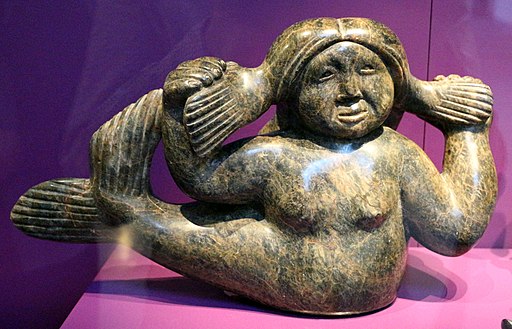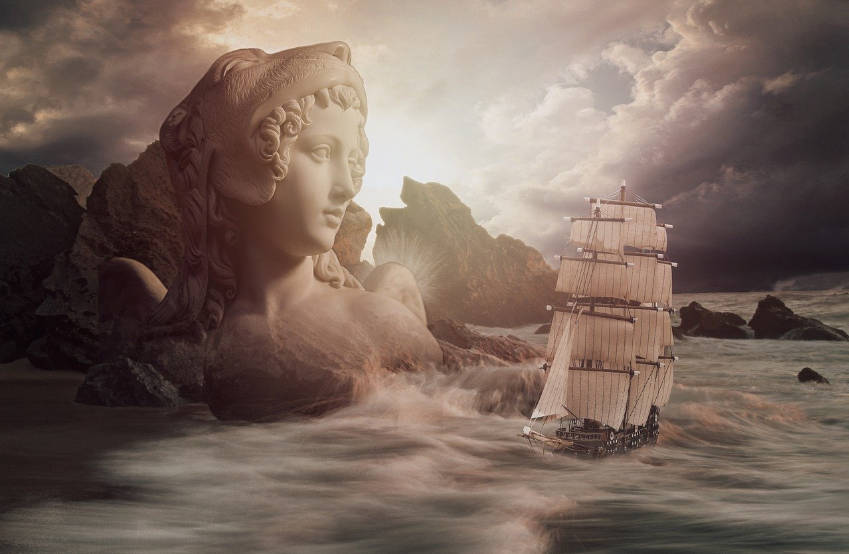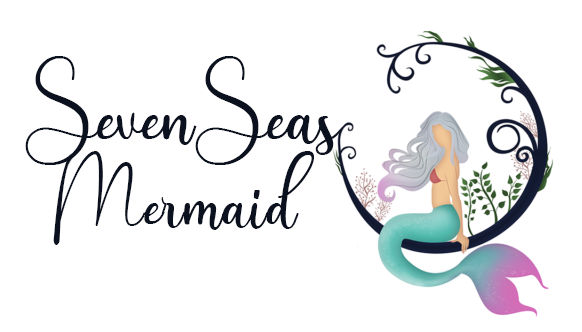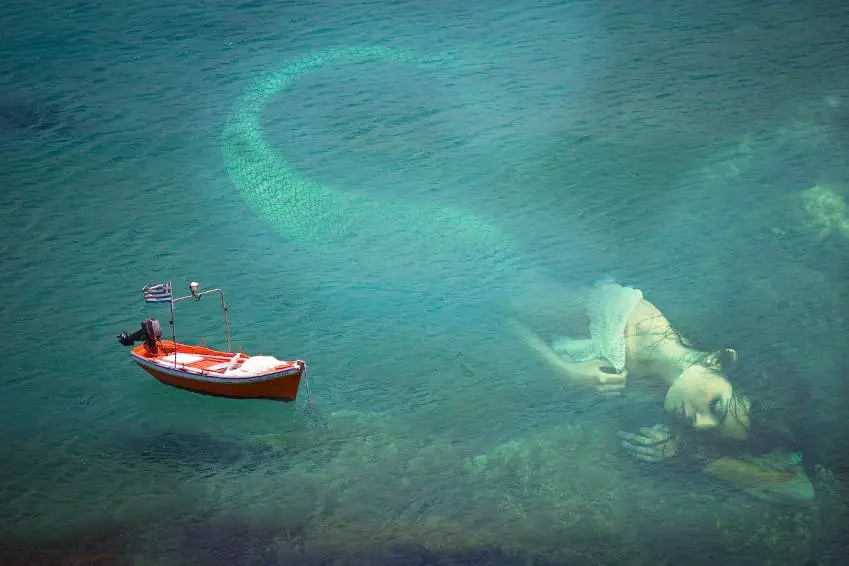On the internet, you can find images of giant mermaids that are three to ten times as big as humans. I wondered, where does this idea of giant mermaids come from and is there actually some myth about them? Here is what I found.
According to medieval Celtic tales, a giant mermaid once stranded on the coast of Scotland. Other than that, there does not exist a lot of folklore about giant mermaids. The giant ocean goddesses Sedna and Kymopoleia can possibly be seen as giant mermaids though.
Let’s have a closer look at who these mermaids were and what their tales tell us.
The giant mermaid that washed ashore in Scotland
During medieval times there was a legend about a giant mermaid that washed up on the shore of Alba. Alba was the name of the kingdom of Scotland back then.
The story, like many other Celtic legends and historic data, was told orally for a few hundred years before four monks decided to write all the Irish history down in the 17th century.
The book became known as the Annals of the Four Masters, after the four monks.
The part about the giant mermaid was mentioned under the year 887 A.D.
Here is what they wrote:
A mermaid was cast ashore by the sea in the country of Alba. One hundred and ninety five feet was her length, eighteen feet was the length of her hair, seven feet was the length of the fingers of her hand, seven feet also was the length of her nose; she was whiter than the swan all over.
Annal M887.14 in Annals of the Four Masters
As you can read, they gave very specific measurements:
195 feet (60 meters) of body length
18 feet (5,5 meters) long hair
7 feet (2,1 meters) long fingers and nose
That was in fact a gigantic mermaid. For comparison, the largest animal on earth is the blue whale who gets up to 108 feet (33 meters) long.
Sadly there is no more information than this about this huge mermaid in the Annals of the Four Masters or any other Celtic source.
So we don’t really know why the people that found her thought that she was a mermaid and what happened to her: Was she still alive when she was cast ashore?
Or was she dead and the description of her white color referred to her skeleton?
In fact, some people believe that what was cast ashore might have actually been a blue whale and the original meaning might have been lost over the centuries because at first it was only told orally.
A skeleton of a blue whale might actually come very close to the description that was given. With 108 feet (33 meters) they can get more than half as long as the allegedly 195 feet (60 meters) long creature.
And even the fingers and nose could easily have been mistaken for the fingers (because they are mammals they have fingers inside their fins) and skull of the whale if it was a skeleton.
You can have a look at a 3D blue whale skeleton on the site of the Natural History Museum if you want to see what I mean.
Nowadays blue whales are rare around Scotland as a result of the heavy whaling around the early 20th century. But back in the Middle Ages, they were still very common in that area.
But of course, this is just speculation. Maybe we can trust these old Celtic people and it was really a giant mermaid.
The description of the long hair does not make sense when talking about a whale after all.
Giant mermaids in mythology
There don’t seem to be any other myths that explicitly talk about giant mermaids.
But there are two myths about ocean goddesses that are giants and who are also sometimes depicted as mermaids!
So, there is in fact also somewhat of a mythological element when it comes to giant mermaids.
The giant Inuit ocean goddess Sedna
A giant ocean goddess that has a connection to mermaids is Sedna from the mythology of the Inuit people in northern Canada and Greenland.
She is the goddess of the sea and of marine animals and also rules over the underworld.
In many depictions and art, she is shown with a mermaid tail.

There are several different stories about her and in one of them she is described as a giant:
She was said to be the daughter of the creator-god Anguta making her a goddess.
But she was so unbelievably hungry that she attacked her parents one day.
Out of anger Anguta took her onto his kayak and rowed out into the sea where he kicked her out into the water.
Sedna desperately tried to cling onto the kayak, so Anguta took a knife and chopped her fingers off.
It is said that she sank to the underworld where she became the queen of the sea monsters.
Her giant fingers, which her father had chopped off, however, turned into the marine mammals that are the most important source of food for the Inuit: the seals, walruses and whales.
So, the idea that she was a giant mermaid seems to exist in Inuit mythology.
The giant Greek ocean goddess Kymopoleia
Giants were nothing special in Greek mythology. Some gods like the Titans and other more recent deities were of giant size.
The Olympic god Poseidon (Neptune) actually had two children with his sea nymph wife Amphitrite that could have sparked the idea of giant mermaids: Triton and Kymopoleia.
Triton is a sea god that is known for his mermaid tail. He might be the most famous merman of all time. His children the Tritons and Tritonides are said to be mermen and mermaids.
Triton wasn’t a giant. But his lesser-known sea goddess sister was: Kymopoleia (Cymopolea) was the goddess of violent sea storms and is often depicted as a giant.

Her name actually means “wave-raging” from the Ancient Greek “Kýma poléo” (Κύμα πωλέω).
The reason why Kymopoleia was thought to be a giant seems to be related to her husband Briareos who was one of the hundred-armed storm giants.
It is believed that she might have controlled the waves at sea that were created by her husband’s storms.
Because of his giant size, she is also mostly depicted as a giant goddess.
We do not have any concrete descriptions of how she looked like but it is possible that she had a mermaid tail given that her brother Triton, who also was a sea god, had one as well.
Other giant mermaids
A popular depiction of a giant mermaid can be found in the anime “One Piece“ which deals with a group of pirates that experience many adventures on their quest to finding a legendary treasure called “One Piece”.
During their travels through the sea, the pirates also end up on the so-called Fish-Man Island where the giant king Neptune, who is a merman, and his mermaid daughter Shirahoshi live.
According to fandom, the mermaid princess measures almost 39 feet (12 meters).
In this video you can see how tall she is compared to the tiny looking humans:
In the anime, this giant mermaid is portrayed as a very kind-hearted, gentle giant that easily starts crying.
Despite her sensible personality, she also has special gifts, that she inherited from her royal ancestors: she has the power to speak to the sea kings, which are dangerous sea monsters who attack ships in the open waters.
The fact that this giant mermaid is the daughter of a king called Neptune seems to be a reference to Roman and Greek mythology, from which most mermaid mythology stems.
Neptune is the Roman version of the Greek sea god Poseidon who is the king of the sea (and the father of Kymopoleia, as I mentioned).
Neptune/Poseidon himself was usually not described as a giant in mythology, though he might have been a bit taller than usual because he was one of the Twelve Olympians – the most powerful gods in ancient Greece.
Another popular big mermaid was a statue called “Die Riesen Nixe” (Engl. “the giant freshwater mermaid”) that was temporarily erected in a lake in Hamburg, Germany, as an art installation.
Besides that, there is a lot of fantasy art on the internet, that features giant mermaids. Here is an example.
Conclusion
The idea of giant mermaids is fascinating. Generally speaking, these kinds of mermaids are simply mermaids that are very tall in size.
As I described, there is a Celtic tale of a huge mermaid that washed up on the shore of Scotland.
In pop culture giant mermaids are often seen as gentle and friendly creatures that are similar to huge whales.
The two goddesses from mythology that could be seen as giant mermaids have darker stories though and are more strongly connected to the stormy sea and sea monsters.



